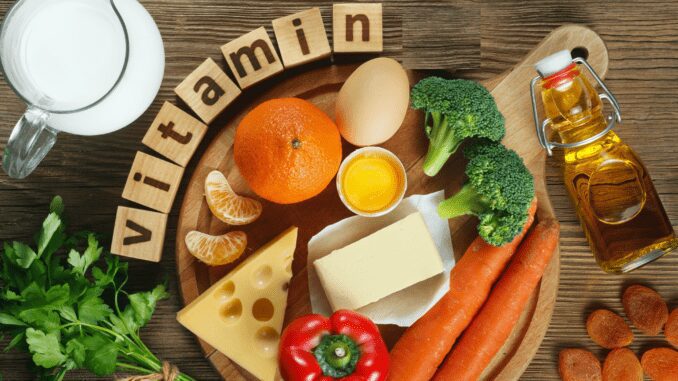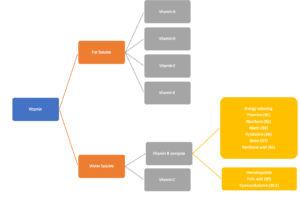
Introduction
Vitamins are organic compounds required by our bodies in a very small amount. These help in the normal functioning of the body and maintain optimum growth and metabolism.
Vitamins act as a catalyst or as a coenzyme. Interestingly one substance that acts as a vitamin in one species does not function as a vitamin in another species. These are complex organic compounds whose chemical structure is very different from one another.
Vitamins can be derived from other food substances or they can also be synthesized as their chemical structure is known to us. The Recommended Dietary Allowance (RDA) has a standard guideline for each vitamin. Different amounts may be recommended for children, older people, lactating mothers, or people dealing with an ongoing disease process (1).

Classification
Vitamins are originally classified according to their solubility in water and fats. They are also classified alphabetically. There is a total of 15 vitamins out of which 13 are essential for humans. Among these vitamins A, D E, and K are fat-soluble whereas C and B groups are water-soluble.
Again, vitamin B complex is further divided into two subcategories namely energy-releasing (B1, B2, B6, and Biotin) and hematopoietic (folic acid and B12).
Vitamins with their food sources and diseases
Vitamin |
Source |
Deficiency symptoms |
| Vitamin A | Carrot, pumpkin, mango, spinach, papaya, liver, eggs, fish and milk, cheese, butter | Night blindness (Nyctalopia), xerophthalmia, growth retardation, dry skin, urinary stone, and. Bacterial infections. Vitamin A deficiency (VAD) in pregnant women causes maternal mortality, poor outcomes in pregnancy, and lactation. |
| Vitamin D
(D2 is ergocalciferol, D3 is cholecalciferol) |
Milk, Fatty fish, fish liver oil, cereals, and D3 are synthesized in the skin by UV rays. | Deficiency is not common as it is synthetizing in our body. But if not synthesized or taken via diet it causes rickets in children and osteomalacia in adults |
| Vitamin E (Tocopherol) | Vegetable oil-rich sources like wheat germ oil, peanut oil, cottonseed oil, sunflower oil, leafy green vegetables, whole grains, milk, butter, egg, and meat. | Sterility. |
| Vitamin K | Cabbage, cauliflower, egg, meat, spinach, broccoli, green vegetables, alfa alfa, tomatoes, egg, meat, liver, cheese. | Deficiency is not so common. Or have deficiency due to body malfunction. It causes delayed blood coagulation. |
| Vitamin C (Ascorbic acid) | Citrus fruits, bell peppers, strawberries, tomatoes, gooseberry, guava, green vegetables (cabbage and spinach), the skin of the potato. | Scurvy (Spongy sore gums and loose teeth, anemia, swollen joints, and osteoporosis.) |
| Vitamin B1 (Thiamine) | Cereals, pulses, nuts, watermelon, soymilk | Beri-beri (loss of appetite, weakness, constipation, mental depression) |
| Vitamin B2 (Riboflavin) | Milk and milk products, eggs, liver, and kidney. | Cheilosis (Fissures at the corner of the mouth), dermatitis and glossitis (smooth and purple tongue) |
| Vitamin B3 (Niacin) | Liver, yeast, meat, poultry, fish, cereals, pulses like beans and peanuts. | Pellagra (rough skin) which ultimately leads to dermatitis, diarrhea, dementia, and death (three Ds) |
| Vitamin B5 (Pantothenic acid) | Egg, liver, mushrooms, meat, yeast, and milk | Deficiency is very low as it is available in almost all food. Causes Burning feet syndrome (pain in toes and sleeplessness and fatigue). |
| Vitamin B6 (Pyridoxine) | Egg, fish, meat, poultry, legumes, tofu, soy products, cabbage, roots and tuber. | Neurological symptoms like depression, nervousness, and mental confusion. |
| Vitamin B7 (Biotin) | Liver, kidney, egg, yolk, milk, tomatoes, soybean, whole grain | Anemia, loss of appetite, nausea, and dermatitis. |
| Vitamin B9 (Folic acid) | Green leafy vegetables, whole grains, cereals, liver, asparagus, organic juices | Mainly occurs in pregnant women, lactating women, and women who are taking oral contraceptives. The main deficiency is anemia. |
| Vitamin B12 (Cyanocobalamin) | Animal-origin food is the only source of this vitamin. Meat, egg, milk, cheese. | Pernicious anemia (Low hemoglobin and decreased number of erythrocytes) (2). |
